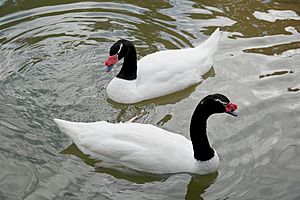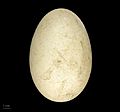Black-necked swan facts for kids
Quick facts for kids Black-necked swan |
|
|---|---|
 |
|
| Black-necked Swan at San Francisco Zoo, USA | |
| Conservation status | |
| Scientific classification | |
| Genus: |
Cygnus
|
| Species: |
melancoryphus
|
| Synonyms | |
|
|
The black-necked swan (Cygnus melancoryphus) is a beautiful swan found in South America. It is the largest waterfowl (a type of bird that lives near water) that is native to this continent.
Contents
What Does a Black-necked Swan Look Like?
Adult black-necked swans are about 102 to 124 centimeters (40 to 49 inches) long. They weigh between 3.5 and 6.7 kilograms (7.7 to 14.8 pounds). Their wings can spread out from 135 to 177 centimeters (53 to 70 inches).
These swans have a bright white body. Their neck and head are black, which gives them their name. They have a greyish bill and a red knob near the base of their bill. A small white stripe can be seen behind their eye. Both male and female swans look similar, but the female is usually a bit smaller. Young swans, called cygnets, have light grey feathers and black bills and feet.
Black-necked swans are usually quiet birds. They are related to the black swan and mute swan. A special thing about these swans is that both parents often carry their cygnets on their backs. The female swan lays four to six eggs in a nest made of plants. These swans mainly eat plants, insects, and fish eggs.
Where Do Black-necked Swans Live?
The black-necked swan is the smallest swan in its group. You can find them in freshwater marshes, lagoons, and along lake shores. They live in southern South America.
These swans breed in places like Southern Chile, Patagonia, Tierra del Fuego, and on the Falkland Islands. When winter comes in the southern parts of the world (austral winter), these swans migrate north. They fly to countries like Paraguay, Bolivia, and southern Brazil.
Some wetlands, like the Carlos Anwandter Nature Sanctuary in the Cruces River area, are very important for these swans. These wetlands were formed after the Great Chilean Earthquake in 1960.
How Are Black-necked Swans Protected?
In 2004 and 2005, many black-necked swans in the Carlos Anwandter Nature Sanctuary in Chile became sick or left the area. This happened because of pollution in the water from a nearby factory. Sadly, thousands of swans were affected.
Even with these challenges, the black-necked swan is found in many places and is quite common. Because of this, the IUCN Red List of Threatened Species lists them as "Least Concern." This means they are not currently in danger of disappearing. They are also listed in Appendix II of CITES, which helps control their trade to protect them.
Gallery
See also
 In Spanish: Cisne de cuello negro para niños
In Spanish: Cisne de cuello negro para niños








